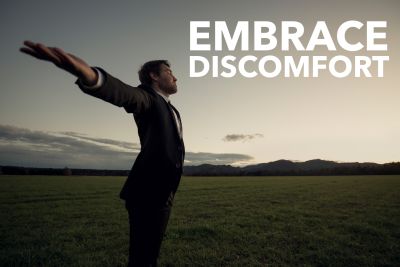
The more you practice embracing discomfort, the more confidence you’ll gain in your ability to accept new challenges. – Amy Morin
Many years ago while in junior high school, I played football. The drills in practice that the coaches put us through were designed to help get us in shape but, also to learn the right way to play the game.
During practice, one coach, in particular, often told us, “Boys, if you’re going to do it wrong, do it wrong to the best of your ability.” This was his way of letting us know that he expected our best at all times. We did our best and that particular year we won our league championship.
When it comes to life and leadership, we tend to be creatures of comfort. We adapt to certain routines, patterns, and ways of doing things. Some are good, some are not, but it’s what we know and do, and change doesn’t always come easy. When we are set in our ways, we tend to choose the path of least resistance over the discomfort of change.
 In his book, Hidden Potential: The Science of Achieving Greater Things, bestselling author and psychologist, Adam Grant has some fascinating insights about being creatures of discomfort. He argues that “the best way to accelerate growth is to embrace, seek, and amplify discomfort.” And in leadership, this is where we often fall short. We try everything we can to run from discomfort. And when we do, we are depriving ourselves of greater learning opportunities.
In his book, Hidden Potential: The Science of Achieving Greater Things, bestselling author and psychologist, Adam Grant has some fascinating insights about being creatures of discomfort. He argues that “the best way to accelerate growth is to embrace, seek, and amplify discomfort.” And in leadership, this is where we often fall short. We try everything we can to run from discomfort. And when we do, we are depriving ourselves of greater learning opportunities.
Grant identifies three forms of courage to embrace. Allow me to share these with you and how they apply to you as a leader.
The first form of courage: Being brave enough to embrace discomfort and throw your learning style out the window.
Grant states, “The way you like to learn is what makes you comfortable, but it isn’t necessarily how you learn best. Sometimes you even learn better in the mode that makes you the most uncomfortable, because you have to work harder at it.”
Embracing the discomfort of a new learning style can be challenging. We would just as soon stick with what we know and do, even if it’s not as effective. Why? We are comfortable.
Leadership Application: When you are unwilling to embrace being uncomfortable and learn new things, you run the risk of being comfortable and stagnant. You might be surprised to learn that the leaders ahead of you are very uncomfortable at times.
The second form of courage: Being brave enough to use your knowledge as you acquire it.
Grant states, “You can’t become truly comfortable with a skill until you’ve practiced it enough to master it. But practicing it before you master it is uncomfortable, so you often avoid it.”
If you start today and embrace the discomfort and mistakes along the way, you will make progress. But if you wait until you are “ready” there will be little progress.
Leadership Application: Don’t wait to step up and lead when you think you’re “ready”. Embrace the discomfort of using new skills and knowledge to make an impact now. If you wait until the discomfort of being “ready” passes, you may never have the opportunity again.
The third form of courage: Not just embracing and seeking discomfort, but amplifying it by being brave enough to make more mistakes.
Grant shares insights into how we learn new languages and why kids tend to absorb foreign languages faster than adults. He states, “They’re largely immune to the fear of embarrassment and the discomfort of making mistakes. They’re not scared of feeling stupid or being judged.” And this is the secret to living with the discomfort – being brave enough to embrace more mistakes.
Leadership Application: In leadership, we tend to do the opposite. We want to avoid making mistakes at all costs. We are afraid of being judged or ridiculed. But the more we embrace mistakes, the closer we are to arriving at new levels of leadership that our comfort zones deny us.
Are you ready to embrace the discomfort of leadership?
©2024 Doug Dickerson
